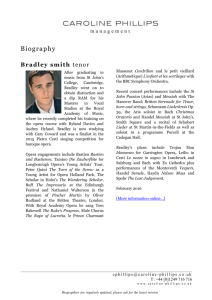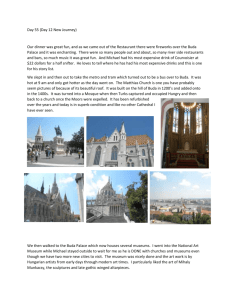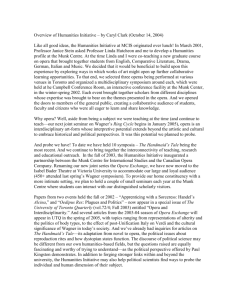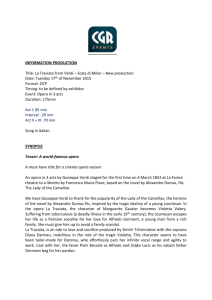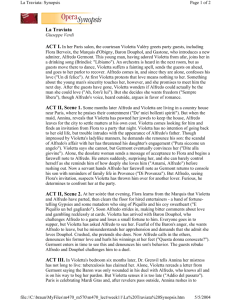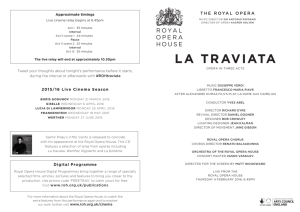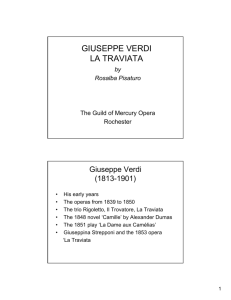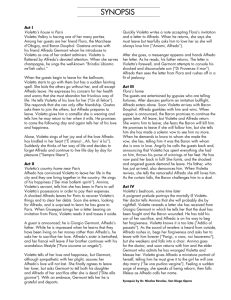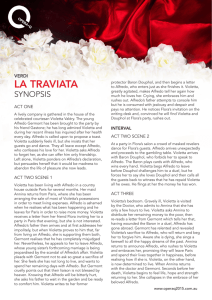PRE-PERFORMANCE LECTURE ON LA TRAVIATA La Traviata is
advertisement
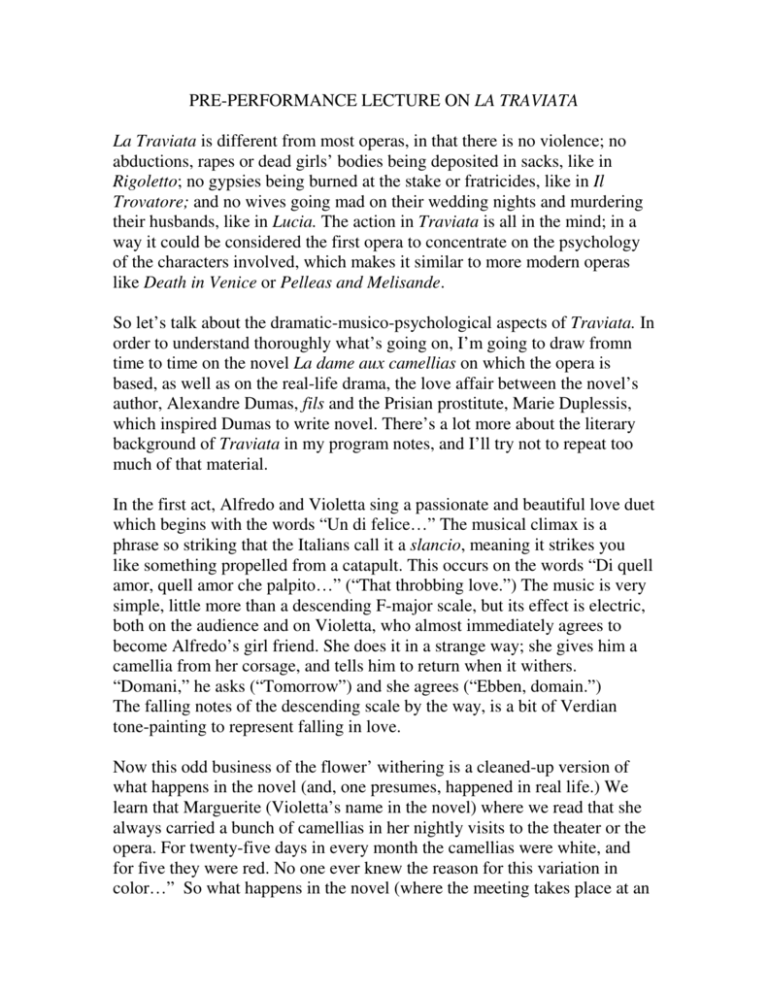
PRE-PERFORMANCE LECTURE ON LA TRAVIATA La Traviata is different from most operas, in that there is no violence; no abductions, rapes or dead girls’ bodies being deposited in sacks, like in Rigoletto; no gypsies being burned at the stake or fratricides, like in Il Trovatore; and no wives going mad on their wedding nights and murdering their husbands, like in Lucia. The action in Traviata is all in the mind; in a way it could be considered the first opera to concentrate on the psychology of the characters involved, which makes it similar to more modern operas like Death in Venice or Pelleas and Melisande. So let’s talk about the dramatic-musico-psychological aspects of Traviata. In order to understand thoroughly what’s going on, I’m going to draw fromn time to time on the novel La dame aux camellias on which the opera is based, as well as on the real-life drama, the love affair between the novel’s author, Alexandre Dumas, fils and the Prisian prostitute, Marie Duplessis, which inspired Dumas to write novel. There’s a lot more about the literary background of Traviata in my program notes, and I’ll try not to repeat too much of that material. In the first act, Alfredo and Violetta sing a passionate and beautiful love duet which begins with the words “Un di felice…” The musical climax is a phrase so striking that the Italians call it a slancio, meaning it strikes you like something propelled from a catapult. This occurs on the words “Di quell amor, quell amor che palpito…” (“That throbbing love.”) The music is very simple, little more than a descending F-major scale, but its effect is electric, both on the audience and on Violetta, who almost immediately agrees to become Alfredo’s girl friend. She does it in a strange way; she gives him a camellia from her corsage, and tells him to return when it withers. “Domani,” he asks (“Tomorrow”) and she agrees (“Ebben, domain.”) The falling notes of the descending scale by the way, is a bit of Verdian tone-painting to represent falling in love. Now this odd business of the flower’ withering is a cleaned-up version of what happens in the novel (and, one presumes, happened in real life.) We learn that Marguerite (Violetta’s name in the novel) where we read that she always carried a bunch of camellias in her nightly visits to the theater or the opera. For twenty-five days in every month the camellias were white, and for five they were red. No one ever knew the reason for this variation in color…” So what happens in the novel (where the meeting takes place at an intimate supper rather than a festive party) is that Marguerite gives Armand (Alfredo’s name in the novel) a red camellia, telling him to return tomorrow, when it will be white. Pretty racy stuff, that, so it got changed for the opera. Getting back to the slancio, it makes several reappearances in the opera. After Alfredo leaves with his flower, Violetta sings her great scena, beginning with the aria, “Ah fors è lui” (“Perhaps he is the one…”). This areia, which begins in f-minor modulates to F-Major as she repeats the slancio. There is then a recitative, followed by her next aria Sempre libera in which she seems to change her mind about Alfredo, and decides to lead a life devoted to pleasure and debauchery. This aria, by the way, is in AbMajor, the relative major to the f-minor of her previous aria, to contrast pleasure and joy (happy Major) with faithful love (unhappy minor). Near the end of Sempre libera Alfredo’s voice is heard offstage, repeating the slancio, but so softly that one guesses that it is actually occurring in Violetta’s mind. (This actually happens twice, as the aria is reprised.0 The slancio occurs twice again, in the last act. First it plays in the background as Violetta reads aloud a letter from Alfredo’s father, Giorgio Germont (referred to simply as “Giorgio”). In opera, speaking to a musical background is called “melodrama;” not what one usually thinks of as melodrama, i.e. a villain with a handle-bar mustache tying an innocent maiden to a railroad track from which she is rescued b the intrepid hero. This appearance of the slancio is in the key of Gb-Major by the way, six flats which was probably Verdi’s way of punishing the orchestra. Finally, at the very end of the opera, just prior to Violetta’s death, we hear it in the key of A-Major. George Bernard Shaw once described the generic opera plot: The tenor and the soprano want to make love, and the baritone tries to prevent them.” This certainly describes Traviata perfectly; Germont, Alfredo’s father, visits Violetta in Act II and persuades her to leave Alfredo because the daughter, pure as an angel, that God gave him, is about to be jilted by her fiancé, who objects to her brother’s relationship with a prostitute. This of course never happened in real life, where Alexandre’s father, author of The three musketeers and similar stories, was as much a libertine as was to be found in Paris (Alexandre, fils himself was the product of an non-marital relationship). But we can conjecture as to why Violetta agreed to leave Alfredo from the real-life saga of Marie Duplessis. Marie was sexually and emotionally abused by her father, who started pimping for her when she was only 12 years old. Subsuming the real Marie with the fictional Violetta, I see her viewing Germont as the loving father she never had, and so she agrees to hi preposterous demands. This is further corroborated by her asking Germont, towards the end of their long, and beautiful, duet to “embrace me like a daughter.” Before Violetta does leave Alfredo, she begs him to love her:“Amami, Alfredo, amami quant’io t’amo”(“Love me Alfredo, love me as much as I love you.”) In the true dramatic sense, this is the climax of the opera, the point to which all the previous action has been leading, and from which the subsequent action evolves. Verdi has also made it the musical climax, with an unforgettable theme, in F-Major, to relate it to the love theme of the slancio. This theme also appears in the prelude to Act I, although in E-Major rather than F. Well, there is a great deal more beautiful music and dramatic highlights in Traviata besides what I’ve talked about, enough to justify its being one of the most popular operas ever written. Good evening (or afternoon) everyone. My name is Paul Zweifel, and I’m the dramaturg of Opera Roanoke. I’ll be joined by my good friend Scott Williamson in trying to give some insights into the opera, La Traviata, that you’ll be watching this evening (or this afternoon). Scott, in addition to singing the role of Gaston in this production, is the assistant conductor. Many of you probably saw him on the podium last year for the Sundayafternoon performance of Rigoletto. I’ll first talk a little about the dramatic aspects of Traviata and then Scott (or should I say, Dr. Williamson) will speak about the music. George Bernard Shaw defined the generic opera plot: A tenor and a soprano want to make love, and a baritone is trying to prevent them from doing it. That might not fit all operas (Hansel and Gretel for example) but it certainly fits Traviata. Tenor Alfredo Germont and soprano Violetta Valery are madly in love, but baritone Giorgio Germont, Alfredo’s father, manages to break up the relationship. He uses the ridiculous excuse that the daughter whom God gave to him and who is “as pure as an angel” is about to be jilted by her fiancé, who is outraged by the relationship between the brother of his wifeto-be and a Parisian prostitute. Violettta accepts this argument, as lame as it is, which Germont presents to her in his son’s absence, and she immediately jilts Alfredo, to everybody’s ultimate sorrow. To understand what is really going on, it is necessary to delve below the surface of the opera to the three layers lying beneath it. The opera itself is layer four; layer three is the play “La dame aux camellias” of Alexandre Dumas, fils. Verdi’s opera is based very closely on this play. The play itself is a revision of the novel of the same name (layer number two) while layer number one is the real-life love affair between Dumas fils and the beautiful Parisian demi-mondaine (i.e., high-class prostitute) Marie Duplessis on which all the other layers are built. We need to study all of these sources to really understand what went on between these unfortunate lovers, Alfredo and Violetta, i.e. Alexandre and Marie. (To make matters even more complicated, their names in both novel and play are Armand Duval and Marguerite Gautier.) Marie-Marguerite got her name, “The lady of the camellias” from her habit of carrying a bunch of camellias. To quote the novel: For twenty-five days in every month the camellias were white, and for five they were red. No one ever knew the reason for this variation in color…” M. spent every evening at the opera, or a ball, and it was at the opera, in fact, that A. first met her, having been introduced by his friend Gaston. Shortly after this meeting, M. is hospitalized for treatment of the tuberculosis which was to kill her only three years later. (In the last act of the opera we learn from Dr. Grenvil what her illness is. He calls it tisi, the Italian word for t.b. In the novel it is called consumption, which I guess is the same thing.) A., who had fallen in love with M. at first sight, goes to the hospital every day to inquire about her health, but never leaves his name. After M. is discharged from the hospital, she throws a party at her house to celebrate (according to the opera; in the novel it is an intimate supper). This is the opening scene of the opera, and Violetta-M. is so touched by the devotion of A. (Alexander, Armand, Alfredo, take your choice) that she agrees to let him become one of her lovers. She does this in a way that was too racy for the Venetian censors (the opera was first presented in Venice). She plucks a red camellia from her corsage, and tells him to return tomorrow for a white one. (In the opera this was changed to the nonsensical business of returning tomorrow when the flower will have withered). The lovers are both 20 years old, by the way.) After the two lovers begin their affair, M.-M.-V. continues to ply her trade until A. persuades her to give it up and move with him to the country, actually the village of Bougival, around eight miles from Paris, along the Seine (in those days, that was country). It is here that Violetta and Giorgio Germont have their encounter in Act II of the opera). The truth of the matter is, in real life the lovers broke up because they ran out of money, and Marie had to go back to her old profession. (One of her new lovers was Franz Liszt, by the way.) In the novel, Armand’s father does enter the picture, and he virtually commands his son to break up with Marguerite in a manner which tells us a lot about French attitudes towards women in those days (1840’s): “If you have a mistress, well and good. If you pay her like any gentleman pays to be loved by a kept woman, even better. But when you negelect your most sacred obligations…allow rumors of your scandalous conduct to travel all the way down to my part of the world…that is something which cannot continue, nor shall it continue.” What Armand’s father is getting at is that his son is living on the earnings of a prostitute, that is he’s a pimp. Those earnings were considerable, by the way. Marguerite was supposed to have earned 200,000 francs per year, in the days that Ch. D’Yquem cost 25 francs per bottle. In today’s terms 200,000 francs would amount to about 60,000 times a workingman’s average daily wage or let’s say $3,000,000. As incredible as this may seem, it’s even more incredible that, in those preincome-tax days she was so poor after six months in the country with her lover that she had to go back to work. Where did all this money go? Well, to buy camellias for one thing—a bunch probably 36 francs or so, so a year’s worth of camellias would have run about 10,000-15,000 francs. Just for flowers. The scene of the opera in which Alfredo hurls his gambling winnings at Violetta’s feet is based on an incident in the novel. When Marguerite allows Armand to spend one night with him some weeks after their separation “for old times’ sake” but then insists that it is their last fling, Armand insultingly sends her 500 francs as payment for her services. In the last act of the opera, Violetta sings “Gran Dio, morir si giovine”— “Great God, to die so young.” Marie did indeed die young; she was only when she die on 23 on Feb. 3, 1847. As we learn from the opera, she died during Carnival—Ash Wednesday in 1847 fell on Feb. 17. As though the final act of Traviata weren’t tragic enough, the thought of the former party girl lying on her death bed while the rest of Paris celebrates Carnival, just adds to the pathos. Additional topics worthy of discussion: Dumas’ novel and play the prototype for realism in French literature and drama of the late 18th century; Zola, de Maupassant, etc. Verdi saw the play on its opening night in Paris, Feb. 2, 1852. Opera premiered at La Fenice, March 6, 1853. Utter failure, perhaps due to the fact that Violetta was “overly plump.” When she was pronounced by Dr. Grenvil to be on the verge of death, the audience erupted into gales of laughter. It was revived on May 6, 1854 in Venice (but a different theater) and this time it was a success, and has been ever since. Traviata prototype for verismo opera, first Carmen and then the works of Mascagni, Puccini, etc.



